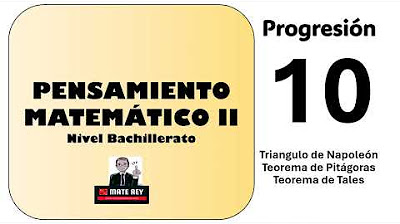Petualangan Pemecahan Masalah: Matematika Multistep di Dunia Nyata
Summary
TLDRIn this video, Adi Cahaya Nugraha discusses problem-solving in mathematics, focusing on strategies for tackling mathematical challenges. He outlines a four-step approach: understanding the problem, planning, testing solutions, and reviewing results. Using practical examples like ants carrying biscuits and math-based scenarios, Adi highlights strategies like creating diagrams, patterns, and tables. He also emphasizes the importance of critical thinking over rote memorization. The video includes exercises for different educational levels and encourages viewers to share their analysis on social media. Adi concludes with a motivational quote on expanding problem-solving skills beyond standard methods.
Takeaways
- 🎯 Problem-solving in mathematics helps develop critical and creative thinking skills.
- 📚 The process of solving math problems involves four key steps: understanding the problem, making a plan, executing the plan, and reviewing the solution.
- 🔍 One common challenge in solving math problems is relying too heavily on memorization instead of understanding and applying concepts.
- 📈 Moving beyond memorization, students should focus on understanding, applying, analyzing, and evaluating mathematical concepts to solve real-world problems.
- 🔢 Problem-solving strategies include demonstrating actions, creating diagrams, recognizing patterns, making tables, guessing and checking, and working backward.
- 🐜 The example of ants carrying biscuits illustrates how to break down a problem into manageable steps by creating and adjusting a plan.
- 💡 Math problems, like splitting a meal budget or calculating average height, can be tackled using similar structured problem-solving techniques.
- 📊 Visualization tools such as tables and diagrams can greatly help in solving complex mathematical problems by making abstract concepts more concrete.
- 🧠 Practicing math problem-solving techniques in everyday life helps students see the relevance of math in real-world situations.
- 💬 Various math problems are tailored to different education levels (elementary, middle, high school), encouraging the application of math strategies in context.
Q & A
What is the main topic discussed in the video?
-The main topic is problem-solving in mathematics, focusing on different strategies and steps to solve mathematical problems effectively.
Who is the speaker and what is their background?
-The speaker is Adi Cahay Nugraha, who has over 7 years of experience in international curriculum education. He goes by the name Adi.
What are the four steps to solve a mathematical problem mentioned in the video?
-The four steps are: 1) Understand the problem, 2) Plan a solution by gathering necessary information, 3) Try out the plan, 4) Review and check if the solution is correct.
What is the benefit of being familiar with problem-solving, according to Adi?
-It helps develop critical and creative thinking, adapt to new situations, and recognize that problems can have multiple solutions. It also connects mathematical problem-solving to real-life situations.
Why do people often struggle with solving mathematical problems, according to the speaker?
-People struggle because they rely too much on memorization of formulas and practice problems, instead of truly understanding and applying mathematical concepts in different contexts.
How does Adi illustrate the problem-solving process using ants?
-Adi uses the example of ants trying to move a large biscuit into their nest. The ants face problems and adjust their plan by breaking the biscuit into smaller pieces, showing the importance of revising a plan when challenges arise.
How can strategies like drawing diagrams or creating tables help in solving mathematical problems?
-These strategies help visualize problems, make it easier to see patterns or relationships, and simplify complex information, making it easier to find a solution.
What example does Adi give of solving a problem by acting it out?
-Adi provides an example of a man buying and selling an accessory. By acting out the transactions (buying at 6,000, selling at 7,000, etc.), one can calculate a profit of 2,000.
What is the benefit of solving a problem by working backward?
-Working backward can help when certain information is missing. For example, if the sum of two numbers is given but one number is missing, solving backward can help find the missing value.
How does Adi connect mathematical problem-solving to real-life situations?
-Adi emphasizes that the skills gained from solving mathematical problems, such as critical thinking and adapting to new challenges, can be applied to real-life situations, such as managing budgets or decision-making.
Outlines

このセクションは有料ユーザー限定です。 アクセスするには、アップグレードをお願いします。
今すぐアップグレードMindmap

このセクションは有料ユーザー限定です。 アクセスするには、アップグレードをお願いします。
今すぐアップグレードKeywords

このセクションは有料ユーザー限定です。 アクセスするには、アップグレードをお願いします。
今すぐアップグレードHighlights

このセクションは有料ユーザー限定です。 アクセスするには、アップグレードをお願いします。
今すぐアップグレードTranscripts

このセクションは有料ユーザー限定です。 アクセスするには、アップグレードをお願いします。
今すぐアップグレード関連動画をさらに表示

Makna dan Klasifikasi Masalah dalam Matematika

problem solving- kemampuan pemecahan masalah

Ler, escrever e resolver problemas | Kátia Smole e Maria Diniz (Org.) I Capítulo VII

How to develop problem solving skills | IIT prof's advice

Vidio praktik Seminar Proposal

Pensamiento Matemático II PROGRESION 10
5.0 / 5 (0 votes)
